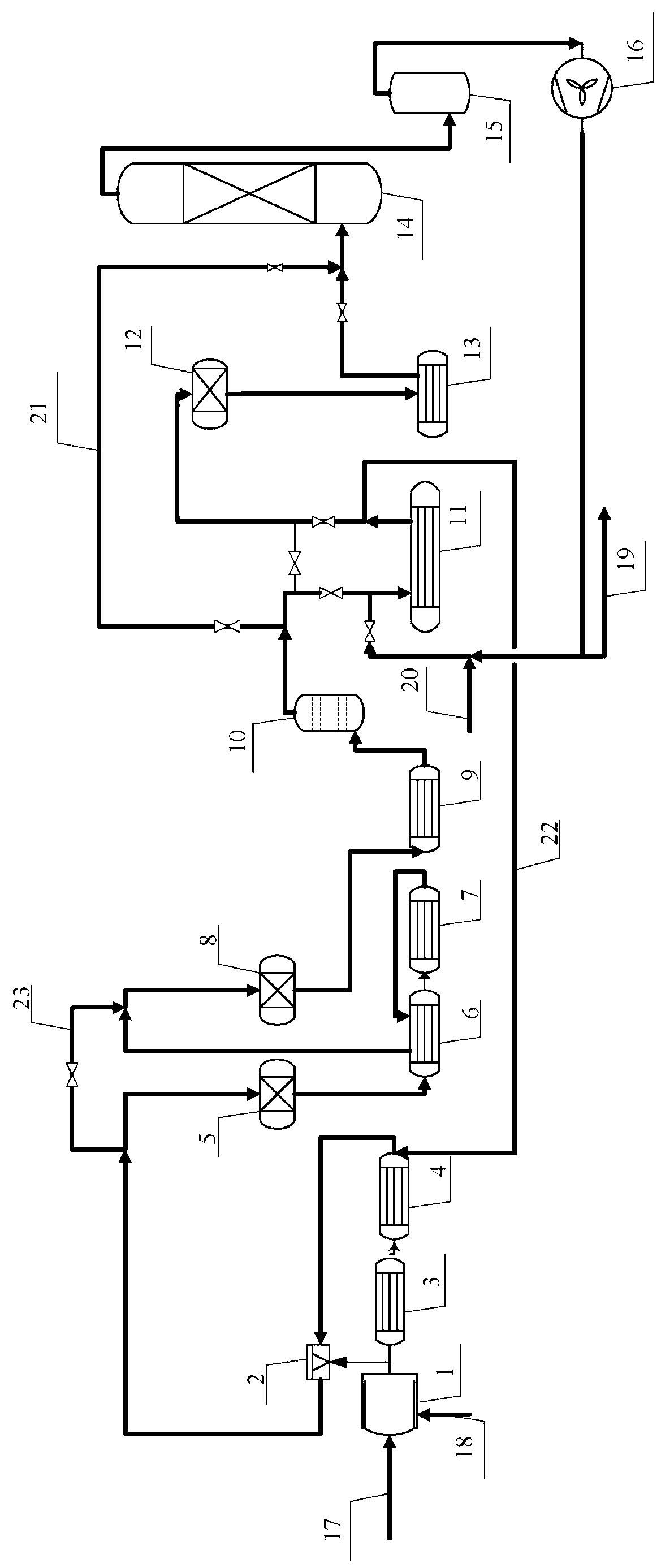Shutdown technique of cleaner production of sulfur recovery and tail gas treatment device
A technology for tail gas treatment and clean production, applied in the preparation/purification of sulfur, etc., can solve the problems of difficult fuel gas combustion control, environmental pollution, system flying temperature, etc., to improve the controllability of the device, low cost, The effect of reducing operating costs and energy consumption
- Summary
- Abstract
- Description
- Claims
- Application Information
AI Technical Summary
Problems solved by technology
Method used
Image
Examples
Embodiment 1
[0049] (1) Sulfur blowing operation of sulfur recovery unit:
[0050] Nitrogen is pressurized by the exhaust fan into the exhaust heater to be heated to 320℃, 80% of the heated nitrogen enters the primary sulfur reactor for sulfur blowing operation, then the gas enters the process gas heat exchanger tube side to cool to 260℃, and then enters In the secondary sulfur cooler, sulfur mist is condensed from the liquid sulfur outlet and enters the sulfur sealing tank; the circulating nitrogen temperature at the outlet of the secondary sulfur cooler drops to 160℃, and enters the process gas heat exchanger shell side and tube side for gas exchange After heating, the temperature is increased to 222℃, and then mixed with the remaining 20% of the heated nitrogen from the tail gas heater, the temperature reaches 260℃ and enters the secondary sulfur reactor for sulfur blowing operation. After the sulfur is blown, the gas enters the tertiary sulfur cooler , The temperature drops to 160℃, the...
Embodiment 2
[0057] (1) Sulfur blowing operation of sulfur recovery unit:
[0058] Nitrogen is pressurized by the exhaust fan into the exhaust heater to be heated to 310℃, 80% of the heated nitrogen enters the primary sulfur reactor for sulfur blowing operation, and then the gas enters the process gas heat exchanger tube side to cool to 247℃, and then enters In the secondary sulfur cooler, the sulfur mist is condensed from the liquid sulfur outlet and enters the sulfur sealing tank; the circulating nitrogen temperature at the outlet of the secondary sulfur cooler drops to 155℃, and enters the process gas heat exchanger shell side and tube side for gas exchange After heating, the temperature is increased to 212°C, and then mixed with the remaining 20% of the heated nitrogen from the tail gas heater. The temperature reaches 250°C and enters the secondary sulfur reactor for sulfur blowing. After the sulfur is blown, the gas enters the tertiary sulfur cooler , The temperature drops to 155℃, the...
Embodiment 3
[0065] (1) Sulfur blowing operation of sulfur recovery unit:
[0066] Nitrogen is pressurized by the exhaust fan into the exhaust heater to be heated to 300°C, 80% of the heated nitrogen enters the primary sulfur reactor for sulfur blowing operation, and then the gas enters the process gas heat exchanger tube to cool down to 240°C, and then enters In the secondary sulfur cooler, the sulfur mist is condensed from the liquid sulfur outlet and enters the sulfur sealing tank; the circulating nitrogen temperature at the outlet of the secondary sulfur cooler drops to 150℃, and enters the process gas heat exchanger shell side and tube side for gas exchange After heating, the temperature is raised to 210°C, and then mixed with the remaining 20% heated nitrogen from the tail gas heater. The temperature reaches 240°C and enters the secondary sulfur reactor for sulfur blowing. After the sulfur is blown, the gas enters the tertiary sulfur cooler , The temperature drops to 150℃, the sulfur ...
PUM
 Login to View More
Login to View More Abstract
Description
Claims
Application Information
 Login to View More
Login to View More - R&D
- Intellectual Property
- Life Sciences
- Materials
- Tech Scout
- Unparalleled Data Quality
- Higher Quality Content
- 60% Fewer Hallucinations
Browse by: Latest US Patents, China's latest patents, Technical Efficacy Thesaurus, Application Domain, Technology Topic, Popular Technical Reports.
© 2025 PatSnap. All rights reserved.Legal|Privacy policy|Modern Slavery Act Transparency Statement|Sitemap|About US| Contact US: help@patsnap.com

